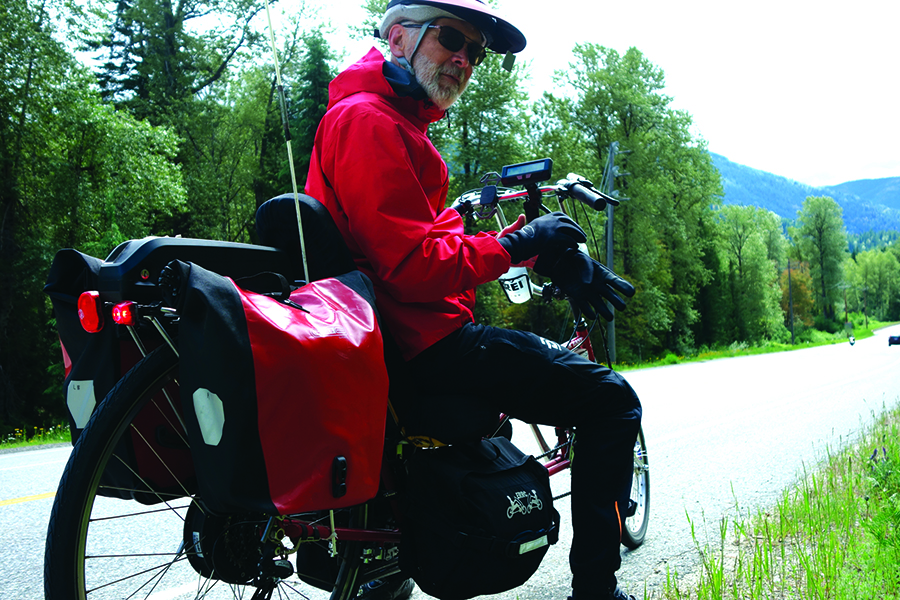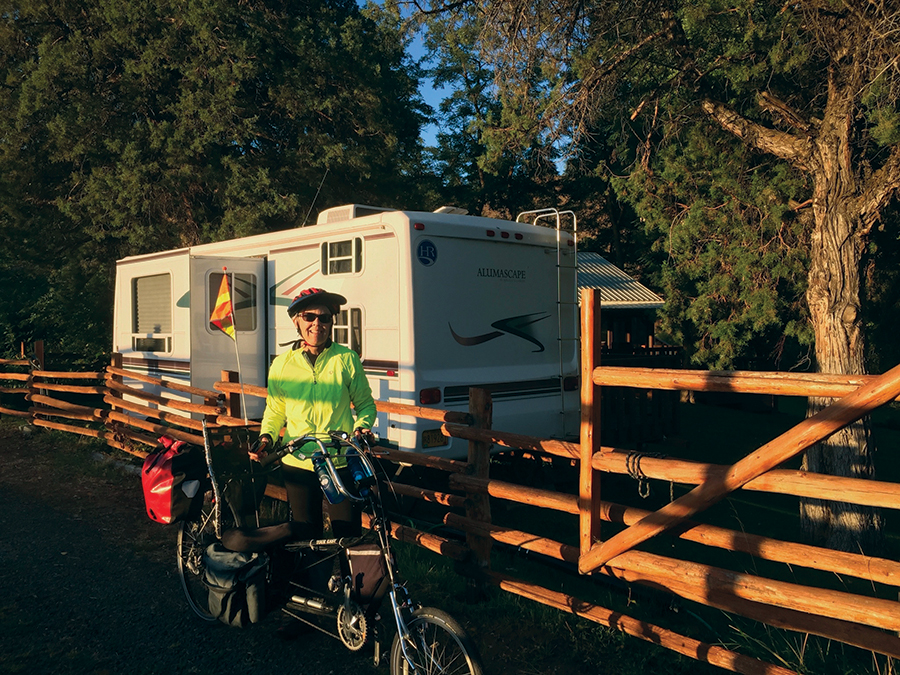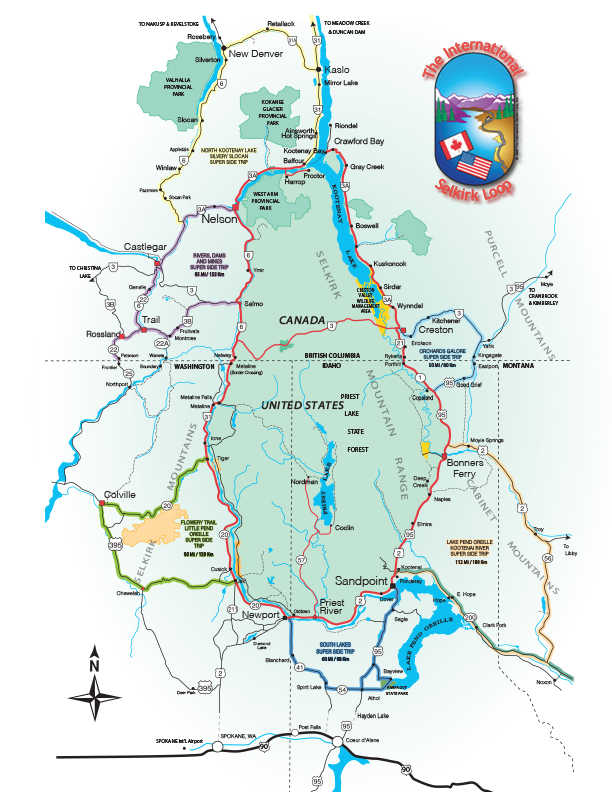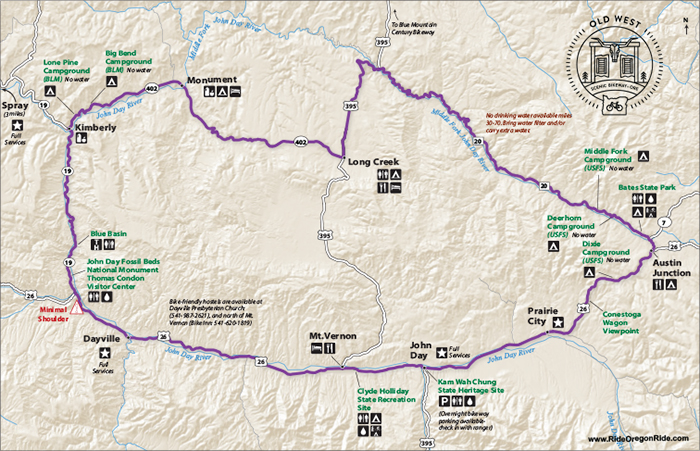Back in the Saddle
This article first appeared in the April 2021 issue of Adventure Cyclist magazine.
As young public school teachers in 1978, we bicycled from central Oregon to Missoula where we joined eight other cyclists for an Adventure Cycling (then Bikecentennial) tour that took us from Missoula to Banff and Jasper, Alberta, and down through interior British Columbia and to White Rock where we caught a ferry to Victoria. It was more than 1,500 miles of self-supported riding through incomparable scenery, accomplished with the strength and enthusiasm of youth.
Forty years later, riding our e-assist recumbent bicycles, we finished two wonderful tours in 2019 and are ready for more. We rode back into BC for the Selkirk Loop and later completed the Old West Scenic Bikeway in central Oregon. What’s different touring on recumbent eBikes as senior citizens compared to doing it 40 years ago on 10-speed road bikes?
We joked to friends that our biggest decision for the night was not where to pitch our tent or keep our food safe from bears. It was whether we would have enough electrical outlets to charge our bike batteries, iPhones, iPads, smart watches, headlights, taillights, and cameras! We also told friends that we could no longer find the $1.99 breakfast specials that had once been our staples, and we used email to keep in touch rather than calling at a local post office for our mail at “general delivery.”
The truth is that our approach to touring has changed in light of our aging bodies and modern technology, but the rewards are as plentiful as ever. We don’t push ourselves as hard, we do more planning in advance, and, most significantly, we made the transition to eBikes.

Shorter days, lighter loads for older bodies
On our previous trip, our diaries show we had some 100-mile days in BC, and we were carrying our camping and cooking gear. Although we were trail-hardened at that point, we were sometimes exhausted and always very hungry at the end of the day. Back then, we didn’t give a second thought to pushing ourselves on steep grades and never worried about our hearts performing their assigned functions.
On our recent trips, we didn’t carry the camping gear and we didn’t push ourselves as hard, even with the electric assist. Yet we still tackled mountain summits and felt as much burn as we wanted to. We typically stopped riding between 2:00 PM and 3:00 PM, allowing time for rest or exploration before dinner. We had less to prove and more time to enjoy. We spent more time checking out local areas of interest and talking to people. In Winlaw, BC, we enjoyed open mic night at the local restaurant, and near New Denver we spent an hour at the Japanese internment camp memorial. We also visited the Glass House near Boswell, BC. It’s built of embalming fluid bottles. You can’t make this up.

Planning
In our younger days, there were more unknowns. We had road maps, but at that time there were often no bicycle maps for our route, so there was a sense of adventure in that we wouldn’t necessarily know each morning where we would find camping or food during the day. Being outdoors every night immerses you in nature in a way that is interrupted with indoor stays. However, staying indoors is more practical for us now. We need the electric outlets to charge, and we appreciate the comfortable beds, the private bathrooms, a comfortable place to cook, dine, and read, and the wifi connections available everywhere.
We still prefer low-traffic roads in less-populated rural areas but without camping gear, so we didn’t want to take the chance that we might end up in a primitive “camp” at the end of the day. We obtained maps to both the Selkirk Loop and the Old West route from the state tourist agencies and read some information from bicyclists who had done these tours earlier. Then we made reservations at Airbnbs or motels.
As we rode, we adjusted the amount of assist that we used. The Selkirk Loop had several variations. The route we selected was about 420 miles, and we averaged between 30 and 55 miles a day depending on our plan for lodging. We followed the Main Selkirk Loop from Sandpoint, Idaho, to Belfour, BC, and then the Super Side Trip from Belfour to Nelson, BC, and returning on the main loop from Nelson back to Sandpoint. Much of the route was along the Kootenay Lake, including a ferry ride across it. There was one very steep climb (thank you, e-assist) but it was short.
Our second tour was the Old West route in Oregon. It required a bit more planning for lodging and food than did the Selkirk Loop. Our longest day was 70 miles into Long Creek, and we arrived at our motel with 30 minutes to spare before the food truck and restaurant closed. This route had more climbs, and we were again very pleased that we could dial in some electric assistance as needed. It was useful not only for climbs, but also for days when the winds came up.

Transitioning away from self-supported tours
In 1977, we met on a self-supported Bikecentennial tour from Missoula to Astoria, Oregon (on the Lewis and Clark Trail), and the following year we did the route in British Columbia, part of which later became the Great Parks North route. For the next 10 years, we continued self-supported touring on our own in Colorado, New Hampshire, Vermont, Washington State, and elsewhere. On these trips, we regularly pedaled 60 to 80 miles a day, often in mountainous terrain.
After a hiatus in our touring due to careers and family, we are now retired empty nesters. We wanted to tour again but thought that we were no longer able to carry all of our gear on routes with one or more mountain passes. As a result, the last five years we have done supported tours including Bike and Barge in Europe and tours in Ireland and Germany/Austria along the Danube with companies that provided maps, bikes, and luggage delivery between hotels or B&Bs. These trips reminded us of our love of touring and suggested that it need not be as onerous as we remembered. We could still enjoy the daily rides, and although we missed camping each evening, it was not a problem to sleep on a real mattress, with air conditioning and no mosquitos.

Transitioning to recumbents
We continued to ride during the no-touring years, and we transitioned to recumbent bikes about 15 years ago. We found that this relieved the sore butt issues and was easier on our knees, hands, and shoulders. On our European tours, we used upright bikes that were provided by the tour companies, and though they weren’t a problem, decided that we continued to prefer our Tour Easy bikes at home. Next up was the Katy Trail — we rode that with our recumbents, staying in Airbnbs along the trail and carrying our clothing and personal gear.
Transitioning to eBikes
Our next step toward more extended touring was the eBike. We took other supported trips with e-assist, including the Adventure Cycling Southern Charm tour and two trips in Italy. We knew that eBikes were right for us because we enjoyed the riding so much more. We didn’t have to worry about riding too slowly and holding up the group, and when we spotted a hill coming up, there was no sinking feeling about how many rest stops we would need on the climb.
After these experiences with recumbents, e-assist, and supported trips, we assessed our situation and decided that we preferred our recumbents, we wanted e-assist, and although we liked the groups we traveled with and intend to continue riding with others, we also liked being able to strike out on our own without luggage transport or provided meals.

Investing in eBikes
Putting all this together began the search for the right bicycles. We couldn’t find factory-made long-wheelbase recumbents that came with e-assist, so we investigated retrofit kits and found one that seemed to meet our needs. We chose kits that we hoped would provide a 100-mile range on one charge, allowing us to keep bicycling in the western U.S. where there can be stretches of trail where services are rare.
The Selkirk Loop was our first opportunity to test the eBikes for touring, followed by the Old West Scenic Bikeway in Oregon. We carried four panniers each, two underseat and two rear, with about 30 pounds of gear. We had many questions about the practicality of using eBikes for touring: Can you do cross-country touring with an eBike? What is the average range on a battery charge? Our longest day (and the route included a summit) would be 70 miles. How much e-assist would we use? Obviously, the more effort you contribute, the longer the range. Our effort is difficult to quantify, but on level or downhill routes, we would dial the e-assist down. We dialed up the amount of assist depending on the steepness of the grade.
We didn’t have any problem with charging the batteries in rural areas of Idaho and British Columbia. We stayed in B&Bs or hotels and took the batteries in with us to charge at night. Our batteries provided sufficient range that we didn’t need to charge during the day. On the Southern Charm Adventure Cycling tour, we rented eBikes with smaller batteries, and at noon we could charge them briefly at churches or at cafés to make it through the day. Everyone we asked said it was fine.
Factory-built or retrofit?
You might ask whether you should go with a factory-built eBike or add a kit to your existing bike. With a factory-built eBike, you should expect everything to work out the door, although it may take a little time to familiarize yourself with the operation. With our kits, we returned to the bike shop that had installed them for additional assistance. Once we refined the setups, the bikes worked well.
One significant difference is in the fine-tuning of the assist: factory-built eBikes typically have three or four levels of assist whereas we have unlimited degrees between the minimum and maximum, which can be controlled through computerized settings.
If appearance matters, consider that the retrofit kits will not be as sleek. For example, the cables on our recumbents are fastened outside the frame, whereas in factory-built eBikes, they are threaded inside the tubes. For us, the advantage of the retrofit kits was that they allowed us to use our own long-wheelbase recumbent bikes. Keith has 3,500 miles on his kit, and Suzanne has 1,000 miles on hers. They work as we had hoped. However, if you don’t want to tinker or don’t have specialized bikes that you prefer, we would advise going with a factory-built eBike.
Technical information
If you’re thinking about an eBike, and you’re worried about the range on a charge or the weight of the bike, you can look at the literature on commercial eBikes or read reviews at electricbikereview.com. This site typically lists the range, components, and weight for a given bike. Bosch has a range calculator as well.
If you’re considering a kit to add to your existing bike, there are many variables to consider. GRIN technologies has a simulator for selecting kit components that will allow you to go a certain distance at a specific speed. It also takes into account the weight (of the rider, bike, and packs), the type of bike, the elevation gain, and the amount of assist you will supply.
We found that our kits allowed us a range of about 85 miles with four panniers on a route with a 4,500-foot summit. Without packs, we have a range of about 115 miles.
Keith has an eZee kit with an 820Wh battery, and Suzanne has an eZee kit with a 680Wh battery. Keith’s total weight of bike, panniers, and rider is about 250 pounds, or 40 pounds more than Suzanne’s. Yet with the different size batteries, we get about the same distance on a charge.
Transporting your bikes is another factor to consider. We bought a minivan a few years ago and have been loading our recumbents into the rear (middle seats removed and rear seats folded down). We wanted to avoid loading bikes on a roof rack, which was increasingly difficult with aging backs and heavier bikes. When loading the bikes, we remove the batteries, stabilize the front with a strap that locks the handlebars in place, and lift our 52-pound bikes into the van. The batteries weight about 9.5 pounds each. There are rear car racks that are designed to carry heavier bikes. The added weight is something to keep in mind if you plan to transport your bike. In addition, there are limits on shipping and transporting batteries that vary by carrier, so check the airline or Amtrak regulations before you buy.
Conclusion
Is an eBike worth it? From the above discussion, there is a lot to take into account, but our bottom line is that we are able to continue doing what we love — bike touring.

